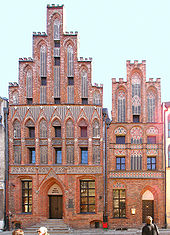

The term Brick Gothic is used for what more specifically is called Baltic Brick Gothic or North German Brick Gothic. That part of Gothic architecture, widespread in Northern Germany, Denmark, Poland and the Baltic states, is commonly identified with the sphere of influence of the Hanseatic League. But there is a continuous mega-region of Gothic brick architecture, or Brick Gothic in a sense based on the facts, from the Strait of Dover to Finland and Lake Peipus and to the Sub-Carpathian region of southeastern Poland and southwestern Ukraine.
Out of northern Germany and the Baltic region, the term Brick Gothic is adequately applied as well.[1][2][3]
The region around the Baltic Sea, including Northern Germany, has some typical characteristics, but there are also regional and social differences, such as between the churches of medieval big cities and those of the neighbouring villages. On the other hand, a significant number of Gothic brick buildings erected near the Baltic Sea could also have been built in the Netherlands or in Flanders, and vice versa.
Furthermore, Gothic brick structures have also been erected in other regions, such as northern Italy, southwestern and central France, and in the Danubian area of southern Germany. The particular architectural styles of some regions differ very much from the others, these are Italian Gothic (with Lombard Gothic, Venetian Gothic and Tuscan Gothic), French Gothique Méridional. Quite late began the medieval use of brick in England, with the Tudor Style.
The true extent of northern Brick Gothic and other Gothic brick architecture is shown by this almost complete list.
- ^ Official Flemish portal on architectural heritage – on churches in Poperinge, "Baksteengotiek van de kuststreek" (Brick Gothic of the coastal region) in Flanders
- ^ Official Dutch portal on architectural heritage – on a village church, "markant stuk baksteengotiek" (striking example of Brick Gothic) in the Netherlands
- ^ Book on a Bavarian brick church "eines der bedeutendsten Werke der Backsteingotik in Bayern" (one of the most important works of Brick Gothic in Bavaria)